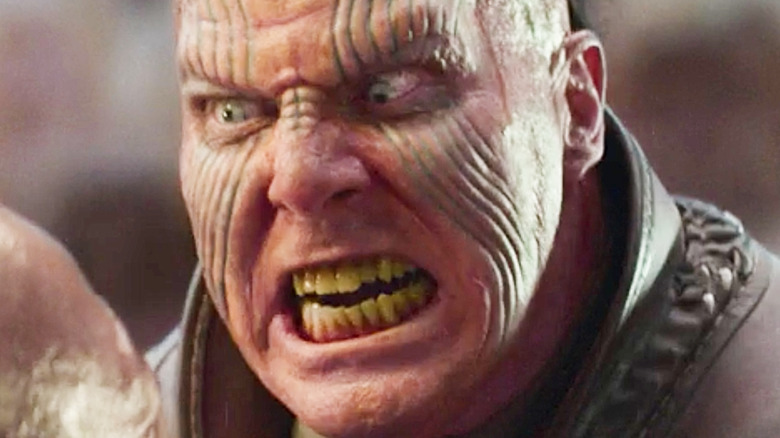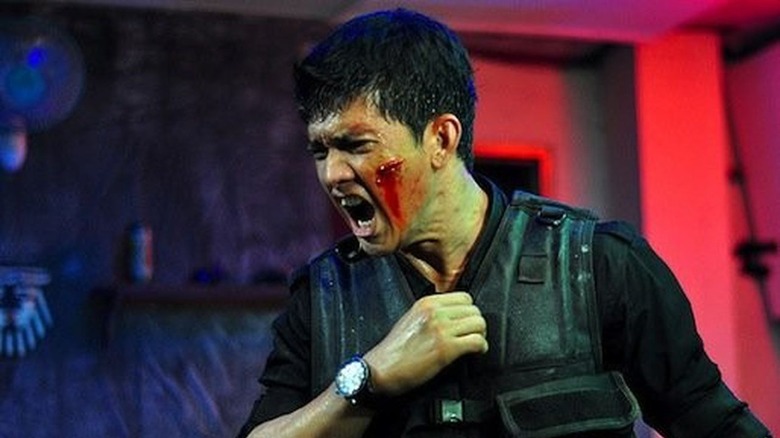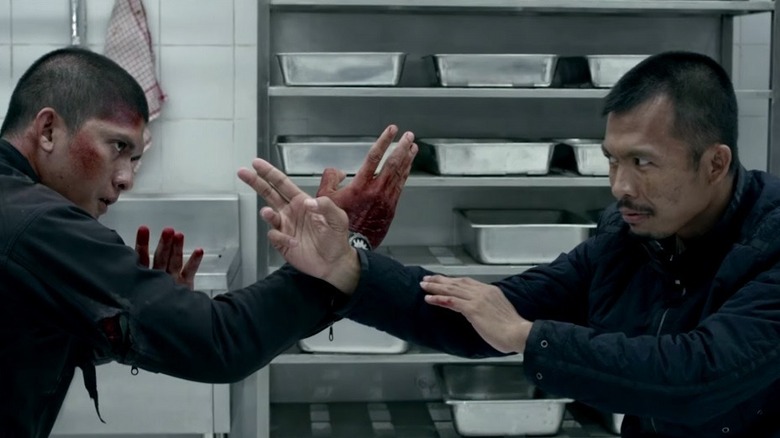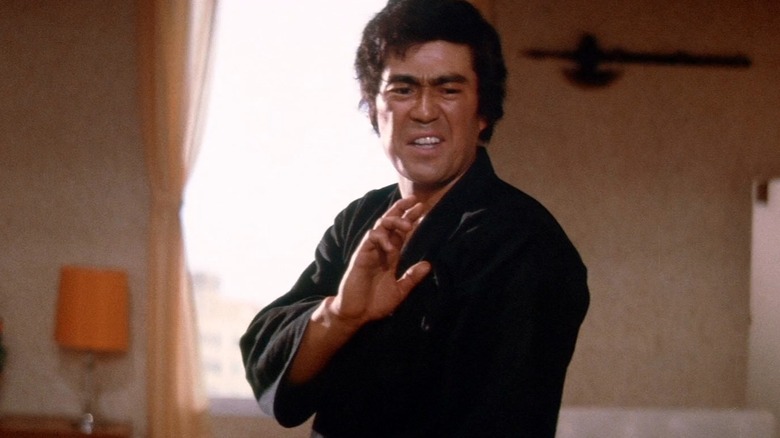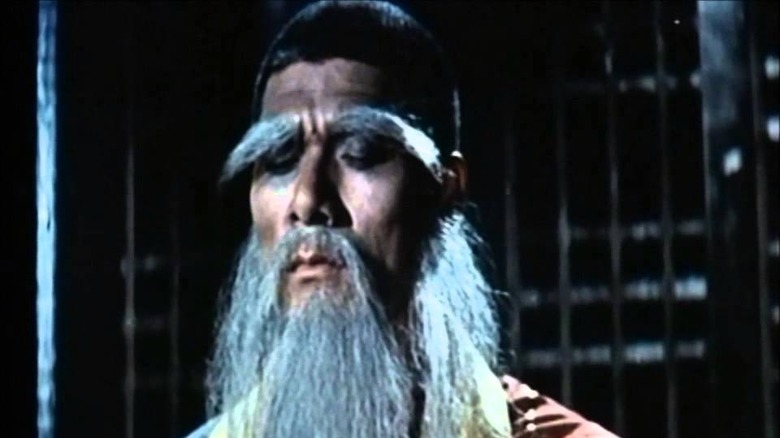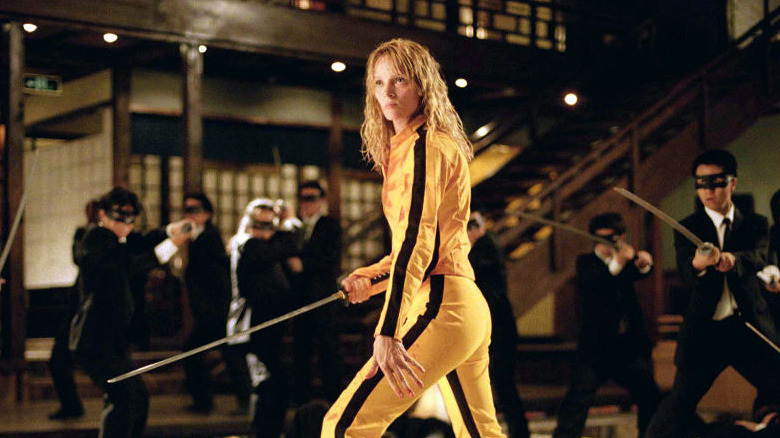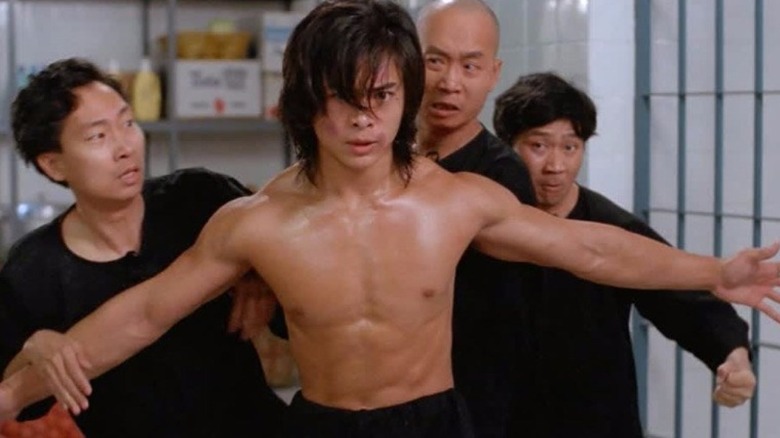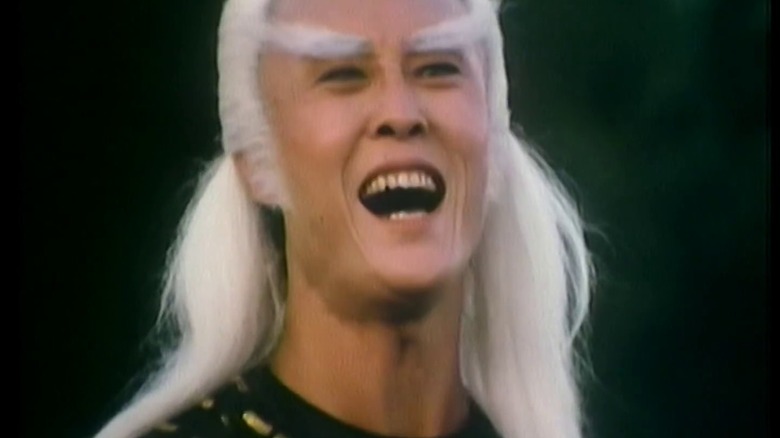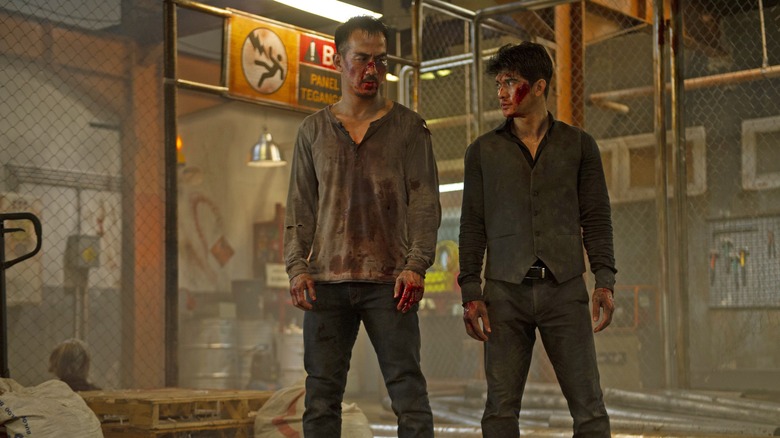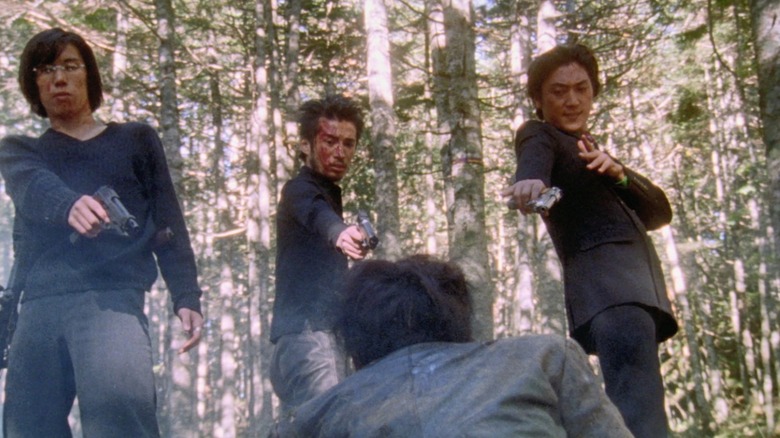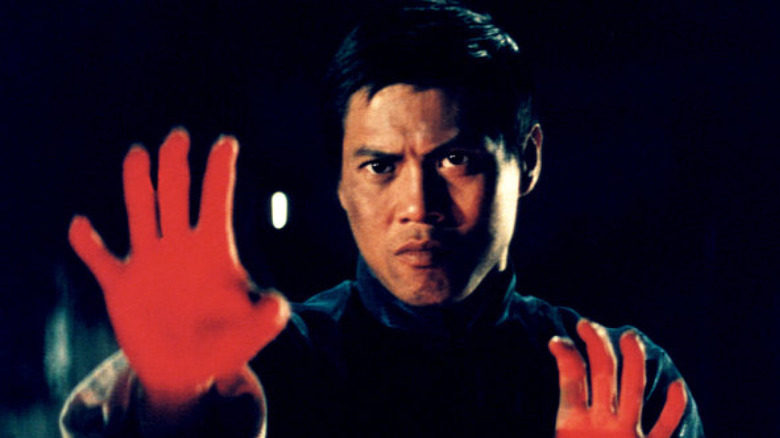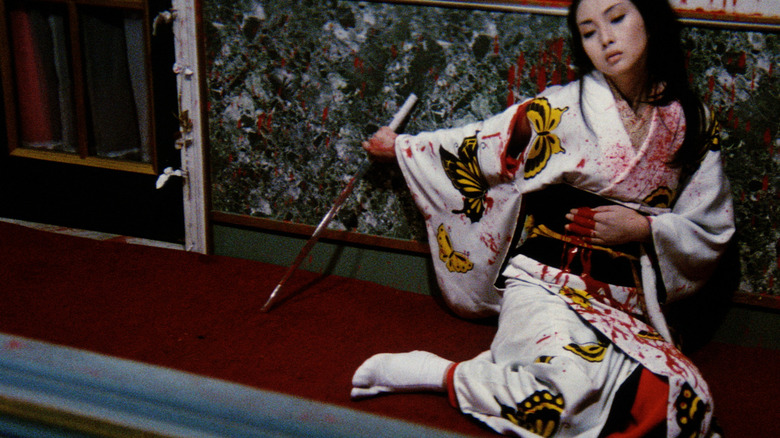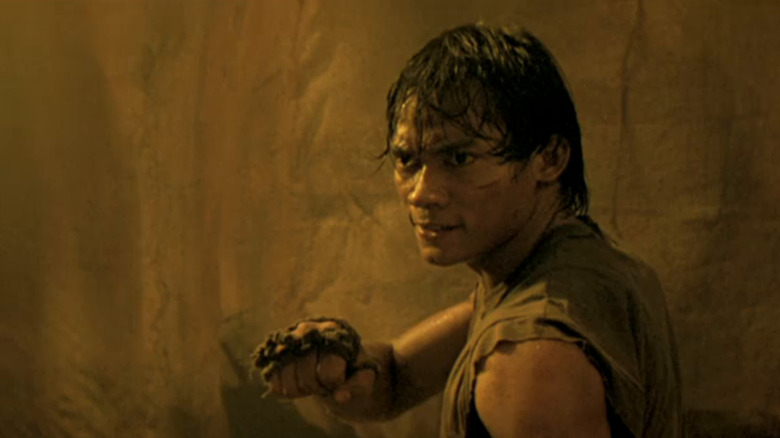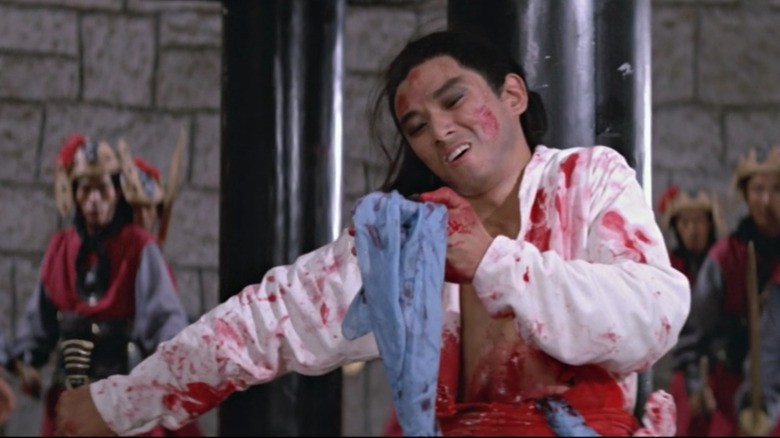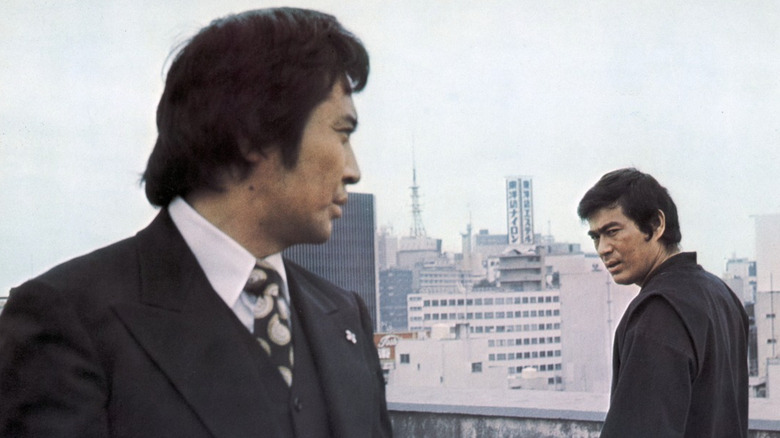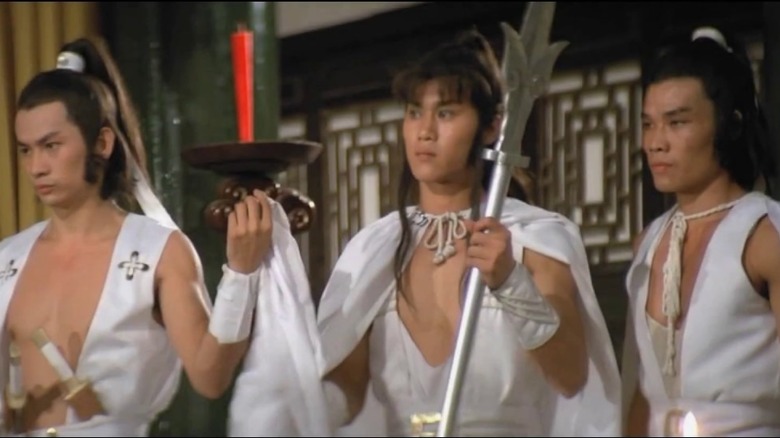Martial Arts Movies Even More Gory Than Mortal Kombat
Like many video game adaptations, including the long-in-the-works "Uncharted" movie, "Mortal Kombat" is a game series that was deeply influenced by movies and eventually got to come full circle to the screen. In fact, "MK" has been given more than a single chance to turn a hit game series into a blockbuster feature film. The franchise has had three chances so far, and the latest "Mortal Kombat" is the goriest one yet — staying true to the franchise's controversial roots.
A number of classic martial arts movies were direct influences on the team at Midway when they were creating the original "Mortal Kombat" in the '90s. The game's brutal aesthetic has also been reflected in films that have been released more recently, part of a worldwide revival of bloody martial arts movies. With that in mind, we've rounded up a selection of pictures that range from over-the-top to straight up hard to watch. If you've seen the 2021 "Mortal Kombat" movie and came away wanting even more blood and guts to go with your martial arts action, then come along with us now.
The Raid: Redemption started an action movie renaissance
"The Raid," which goes by the subtitle "Redemption" in the West, elevated the status of Indonesian action movies globally and brought its stars to a wide audience. Stuntman and choreographer Iko Uwais went on to become the lead in the Netflix original "Wu Assassins," while co-star Joe Taslim is set to do three more movies as Sub-Zero in the "Mortal Kombat" series. At the time of its release in 2011, "The Raid" was considered refreshing, intense, and — of course — extremely violent.
A decade later, it's easy to see how "The Raid" led a recent wave of stylish action movies that took the focus away from the CGI showdowns that had been popularized previously. Movies like the "John Wick" series and "Mad Max: Fury Road" focus on close-range, intimate action that's much more about choreography and stunt work than effects.
They made an even bloodier sequel in 2014, but "The Raid 3" isn't something that is going to happen anytime soon — at least according to director Gareth Evans, who's been pursuing other projects.
The Raid 2 has been banned for graphic violence
Both of Gareth Evans' entries in the "Raid" series are beloved by kung fu aficionados and critics alike. Known for its intensely choreographed and beautifully executed fight sequences, "The Raid: Redemption" spawned a comic book adaptation and a proposed English-language remake that has spent years in development hell with no signs of emerging. But it's the direct sequel, "The Raid 2," that amps up the brutality and gore.
When it was released in 2014, "The Raid 2" attracted controversy due to its extreme violence — in fact, one critic called it "the most violent movie ever made." The movie was banned in Malaysia due to its numerous scenes of excessive violence, which led to some minor censorship and deleted scenes in the US and Japanese releases. The handful of deleted frames that Western audiences didn't get to see must have been extremely graphic based on what wasn't cut, but according to Evans, those edits are pretty minimal. Still, it speaks to the movie's extremity that even an R rating couldn't handle the goriest of what "The Raid 2" served up.
The Street Fighter inspired Mortal Kombat's x-ray fatalities
This movie's title has nothing to do with the "Street Fighter" series of games, although it's possible that the game series was influenced by the gory classic Japanese martial arts film of the same name. In actuality, 1974's "The Street Fighter" has more in common with "Mortal Kombat." On a rampage to save his sister from the Yakuza, Terry Tsurugi (storied actor Sonny Chiba) gouges out eyes, delivers death blows with his fist, and even castrates a man with his bare hands in the original release.
In one scene, Terry punches a mobster so hard that we see an x-ray shot of his skull cracking and shattering. This inspired the x-ray specials that were introduced to the games in "Mortal Kombat" (2011) and were also prevalent in the animated feature "Mortal Kombat Legends: Scorpion's Revenge."
"The Street Fighter" was so gory that it originally received an X rating in the UK and was left unrated in the US. An edited version brought this down to an R rating, allowing the movie to be more widely released.
Master of the Flying Guillotine is like a Kung Lao spin-off
"Mortal Kombat" fans love Kung Lao's bladed hat and all the gory fatalities it's brought to the game series over the years. Kung Lao has been dismembering fools since 1992 and while James Bond villain Oddjob is often cited as the main inspiration, Hong Kong was doing deadly flying hats as far back as 1976, with "Master of the Flying Guillotine."
Written and directed by its star Jimmy Wang Yu, "Master of the Flying Guillotine" is a sequel to Wang's martial arts classic "One Armed Boxer." Wang returns as Yu Tien Lung, the titular boxer, to face off against an assassin with a penchant for taking heads. The hat that villain Fung Sheng Wu Chi wields attaches to the head of the opponent before a forceful yank severs it from the body — a cold-blooded finisher that feels totally in line with "Mortal Kombat." Oh, and the soundtrack went on to be sampled in a future classic bloody martial arts movie...
Kill Bill is a bloody homage to Westerns and martial arts
Quentin Tarantino's two-part epic "Kill Bill" is as much a homage to the movies the director grew up watching as it is its own gory, original thing. Martial arts is just one of the forms "Kill Bill" draws influence from — the other major one being the Western. In the four and a half hours of its combined runtime, "Kill Bill" has plenty for gorehounds to enjoy.
Tarantino brings his signature blood and guts to the party. The fight at the end of the first chapter, when Beatrix (Uma Thurman) takes on the Crazy 88 at the House of Blue Leaves, is one of the best Tarantino has put onscreen — a bloody, perfectly choreographed sequence that makes its mark by being excessively violent in comparison to many of its influences. With blood and limbs flying everywhere, this scene only scratches the surface of "Kill Bill" and Beatrix's bloody cross-country revenge rampage.
Riki Oh: The Story of Ricky is outrageously gory
Based on a manga, this cult classic of Hong Kong cinema is a must-watch if you love blood, guts, and practical effects. "Riki Oh: The Story of Ricky" is a nearly forgotten film, but if you love the body horror of John Carpenter or David Cronenberg, this is sure to scratch that itch.
Before his role in the "IP Man" movies, Louis Fan starred as Ricky in this 1991 prison escape extravaganza. After getting revenge on the mobster that killed his girlfriend, Ricky is sent to prison. He fights to escape and survive in numerous sequences featuring organs being punched out of bodies and people being beaten into a literal pulp. The mess is a sight to behold throughout.
The best is saved for last when Ricky finally faces off against the prison warden. After the warden's transformation to his monstrous true form, the two have their final battle. It ends with the highlight of the whole thing: Ricky throws the warden into a meat grinder, pushing him through until he becomes mincemeat and sparing nothing but the head as a gory trophy.
Ninja Hunter features a ninja who pours acid on himself
"Ninja Hunter" is absolute chaos. Also known as "Wu Tang vs. Ninja", this movie is 90 minutes of pure blood-pumping action, with plenty of incredible fake blood for you to gleefully watch spew. It stars renowned Taekwondo artist and ninja action veteran Alexander Rei Lo as the titular "Ninja Hunter" and of course he has to fight the Wu Tang Clan — no, not that Wu Tang. Don't worry, there is plenty to make you gag in this late '80s gem.
"Ninja Hunter" has some blood-soaked kills, but the highlight is a gross-out scene with body horror elements in which we see a ninja douse himself in acid, spreading it to anyone he touches. He then proceeds to fight off multiple opponents at a time as his face melts off. The acid ninja's glory is short-lived when he is crushed in the next scene. Oh, and at one point a ninja transforms himself into a flying carpet. That's not gory ... just extremely strange. But that carefree oddness is what makes "Ninja Master" worth watching.
The Night Comes For Us is like The Raid but bloodier
2018's "The Night Comes For Us" reunited "The Raid: Redemption" stars Joe Taslim and Iko Uwais. Naturally, expectations were high — and "The Night Comes for Us" delivered for fans of the genre. This hard-hitting thriller is full of mind-boggling violence and brutal hand-to-hand combat. Variety called it a "cartoonish cavalcade of carnage," and they were far from alone in noting that "The Night Comes for Us" is definitely not for the squeamish.
Like the set pieces in the "Raid" films, the fight choreography in "The Night Comes for Us" depicts a style of particularly brutal martial arts known as pencak silat. Add gallons of blood to that style (seriously, the blood level in this movie is off the charts for something that isn't intended to be horror), oozing stab wounds and fights raging on with nonstop intensity, and you've got yourself a real treat for genre fans. At one point someone even gets impaled by a cow femur. It's mighty gnarly.
Versus is a martial arts-inspired take on the zombie genre
"Versus" is unlike any yakuza movie you've ever seen. This 2000 sci-fi horror outing combines the zombie and crime genres and throws in just enough martial arts and samurai spice for the whole thing to feel like a completely new blend. The cult success of "Versus" is what led to the professional ascent of Japanese filmmaker Ryuhei Kitamura, who went on to direct "Godzilla: Final Wars," "The Midnight Meat Train," and the cutscenes of "Metal Gear Solid: The Twin Snakes" for the Gamecube.
In "Versus," a group of yakuza must fend off an incoming zombie invasion — through a dark portal, no less — while chasing after two escaped prisoners that might just have the answers they need to save Japan. It's full of twists and turns and enough gleeful gore to keep most "The Walking Dead" fans satisfied. (Word of warning: The R-rated version originally released in the US removed four of the grisliest minutes from the movie.)
Five Fingers of Death was integral to starting the Kung Fu craze
Bruce Lee's "Enter the Dragon" took international audiences by storm when it was released in 1973. It's often given most of the credit for introducing Western audiences to martial arts films, but it was actually one of many released that year. One of the more influential and violent offerings from that year's bumper crop is "Five Fingers of Death," a.k.a. "King Boxer."
The movie takes the now-familiar premise of two rival schools training for a martial arts tournament and turns it into an unusually bloody affair. Early on in the story, protagonist Chi-Hao (Lo Leih), a dedicated and powerful martial arts student, is overrun by Japanese assassins and tied to a tree, his hands beaten to bloody pulps. Another particularly gruesome moment occurs when the villain Ming Dung-Shun commands his son to blind a man with his bare hands. The funniest part is that, beneath all the spine-chilling gore, "Five Fingers of Death" really is a love story at its heart.
Lady Snowblood is a gruesome Japanese period piece
In 1973, revenge fantasy wasn't the popular thriller subgenre it is today. Before "The Handmaiden," there was "Lady Snowblood." With its love for bloody splatter and personal tragedy, it's the quintessential female-driven revenge film, as poetic and beautiful as it is disgusting. This is one of those movies that makes it impossible to look away, even when you should.
Based on a manga, "Lady Snowblood" is the story of Yuki (Meiko Kaji), a young woman in 19th century Japan on a bloodthirsty quest for revenge after the murder of her brother and father and the rape of her mother. Using her killer umbrella and Samurai sword, Yuki cuts through legions of men to find the ones responsible for her trauma. Told out of chronological order, the story served as major inspiration for Quentin Tarantino's own female-driven martial arts revenge tale, "Kill Bill."
Ong Bak: The Thai Warrior brought Tony Jaa to martial arts fame
You can't talk about contemporary martial arts movies without mentioning Tony Jaa. One of the major leading men to come out of this scene, Jaa enjoyed success in the international market before making his US breakthrough in "Furious 7." Fun fact: Before all the fame, Tony Jaa was actually a stunt double in 1997's "Mortal Kombat: Annihilation."
"Ong Bak" follows Ting (Jaa), a man who happens to be a surprisingly proficient martial artist, and his quest to recover his village's stolen idol from Bangkok. He gains allies and ends up on the wrong side of the mafia, all the while making sure to show off the film's signature fighting style of Muay Thai. In one particularly hard-to-watch sequence, Ting is forced to block a saw blade with his bare arms. It is the goriest this movie gets, and it'll be lodged in your memory for years.
The Assassin features a young Jimmy Wang Yu
Director Chang Cheh has been called the godfather of Hong Kong cinema, and for good reason — he made just shy of 100 movies in his nearly 50-year career. In 1967, the same year he put out "Mortal Combat" (the title of which may or may not have helped inspired the name of the game series), the director also teamed up with a young Jimmy Wang Yu to make "The Assassin." The movie is a dialogue-driven drama punctuated by moments of extreme violence — much like the type of works Tarantino was influenced by.
Set during the Six Kingdoms era of China, the film stars Yu as Nieh Cheng, a swordsman who is broken out of his life of tranquility and sent down the murderous road toward vengeance. (Bad for him, good for the audience.) The closing stretch of the movie delivers after a slow set-up: As Yu slices through dozens of soldiers, his white robes take on a gradually deeper and deeper shade of red, stained with the blood he's spilling.
The Bodyguard was a major influence on Pulp Fiction
Another Sonny Chiba joint, "The Bodyguard" (or "Karate Kiba"), is a 1976 martial arts flick that had a big influence on Quentin Tarantino. Chiba stars as a karate master named Kiba who's on a mission to take out the local drug lords and act as protector to anyone willing to help him. "The Bodyguard" packs a handful of bloody kills, but the goriest is a scene in which a man's arm is twisted so hard you see his bone poke through the skin and come out of his elbow before the limb severs entirely. He's then shot to death in a moment of extreme overkill, each bloody exit wound staining the white wall behind him.
Chiba's "The Bodyguard" is tough to track down today, but its influence is seen in the work of the modern directors currently carrying martial arts movies forward — including Samuel L. Jackson's "path of the righteous man" speech in "Pulp Fiction," which is ripped from the opening monologue of the English dub of this film.
Five Elements Ninjas is another Chang Cheh bloodbath
Also known by the much cooler title of "Chinese Super Ninjas" in some versions, Chang Cheh's "Five Elements Ninjas" is another classic ninja revenge fantasy. After martial arts master Yuan Zeng's school is invaded by the rival clan ran by chief Hong, his best students head out on a quest for revenge and justice with a body count. Top pupil Hao and a group of fellow students have to face Hong and the legendary Five Elements Ninjas. The two invading factions join forces to try and bring about the end of Zeng's line.
The end result is a group battle between Hao's team of heroes and the deadly ninjas. When just their leader Mudou remains — after much struggle — Hao miraculously manages to trap his feet in a shackle while the other students spear his front half, pinning him to the ground. The splatter begins when the group tears Mudou in half, blood and viscera flying everywhere in a satisfyingly gory final minute.
